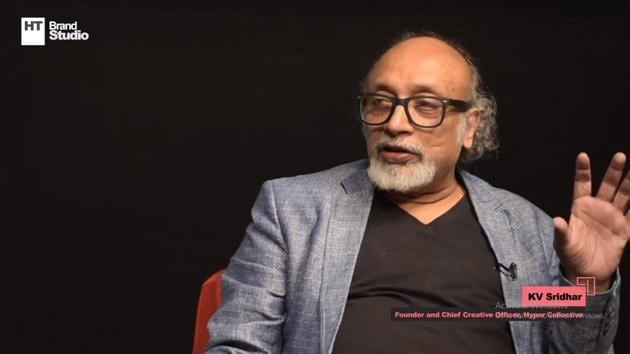A touch of nostalgia: Hypercollective’s Pops aka KV Sridhar takes us down memory lane
Most of us millennials saw some of the most memorable and creative work being woven into magical stories by the big names of advertising across the globe. We spoke to Pops aka KV Sridhar of Hypercollective at the Brand Studio Live, part of the HT Brand Leadership Series.
He’s been in the advertising industry since before most of us were even aware of what advertisements were, what comprised them, the process, the models, and most importantly, the storyboard. Growing up in the nineties was an interesting time for most of us millennials as we saw some of the most memorable and creative work being woven into magical stories by the big names of advertising across the globe.

We spoke to Pops aka KV Sridhar at the Brand Studio Live, part of the HT Brand Leadership Series, an event hosted jointly by HT Brand Studio and DMAasia. The event, which brings together the brains behind the country’s top brands, is an annual property launched by Hindustan Times Digital Streams. The topic titled, ‘The Future is Vernacular: Engaging the native digital consumer’, was designed to throw light on an interesting aspect of consumer behaviour - how vernacular languages help brands communicate and connect better with their consumers and how consumers react.
It was meant to be a simple Q&A with Pops, but it turned out to be a walk down memory lane when he was generous enough to give a decade-wise breakdown and history of advertising during our 57-minute long conversation, starting from the 1960s and onwards. The best part, of course, was soaking in all the information that one can only hope to get from reading material available on the topics we discussed.
Here’s an excerpt:
On brands going local, speaking in vernacular languages
“If there are 40 channels delivering news to me in Telugu, why would I want to shift to an English or a Hindi channel?,” asks Pops. I couldn’t agree more. Just like the age-old proverb goes - When in Rome, do as Romans do. We’re all in the proverbial Rome and want brands to speak our language so we feel the connect easily. According to Pops, advertisers sitting in a megacity like Bombay/Mumbai cannot understand what the consumer in a smaller city would want or appreciate. He adds jokingly, how it would be to imagine Arnab Goswami speak in Tamil to get his point across.
That’s true else OTT platforms like Hotstar, Voot or Zee5 would not be vying for a customer’s attention by speaking in their language or getting a face (mostly a popular name in the film or TV industry) speak it on their behalf. Likewise for a brand advertising their products through a plethora of media available. Where content is king, the right communication is the prime minister when we speak about brand communication.
On bringing vintage back
Those ads, jingles, music, and storytelling evokes a sense of nostalgia for anyone who has grown up watching the ads in the late eighties and primarily nineties. Dairy Milk would not become a dessert of choice at the dinner table had Cadbury (now Mondelez) not touched a chord in the consumers’ hearts; or then child actors namely, Shahid Kapoor, Ayesha Takia, Parzaan Dastur, not gained instant popularity had it not been for the memorable ads they did for Complan and Dhara, respectively. Even Deepika Padukone debuted for Close-Up because of her million-dollar smile that warms people’s hearts. And who can forget Aishwarya Rai as Sanjana for the Coke ad before she went onto win the Miss World crown for India? Ash was introduced to the glamour world by ace ad filmmaker, Prahlad Kakkar.
But can any of these be brought back? Not really. The brands can, however, tell better stories and find effective ways of being their target group’s (TG) best friend, someone who knows what they want.
On Mad Men
A phenomenon which took over Britain and the United States, the concept of Mad Men took over Indian advertising too in the sixties and seventies. As seen in the popular TV show by the same name, this concept spread far and wide and as Pops says, “between 1 to 4, you could be invited for a drink with your boss if he liked you.”
Adding to this interesting revelation, Pops mentions how the second generation of the Mad Men came from the smaller towns of the country and became names to reckon with in the world of advertising.
On ad filmmakers with Bollywood dreams
A trend that started in the nineties, writers started aiming for Bollywood but were hardly successful back then. As time has passed, however, a large number of ad filmmakers have found glory in B-town by telling some compelling and riveting stories which have touched people’s hearts and got them the requisite adulations. The most-recent ad person to jump onto this bandwagon is Amit Sharma who has directed one of the most popular films this year, Badhaai Ho.
Well, if the content is great, the audience is most likely to consume it. Don’t you agree? Pops has also written a book titled 30-seconds thrillers - chronicling the behind-the-scenes of every loved ad from the age of Doordarshan to YouTube today. The book also contains interviews of creative heads and directors of all generations, vintage and new. In other words, this 284-pager brings the entire ad industry together.
Also watch him in the Brand Studio feature here:






